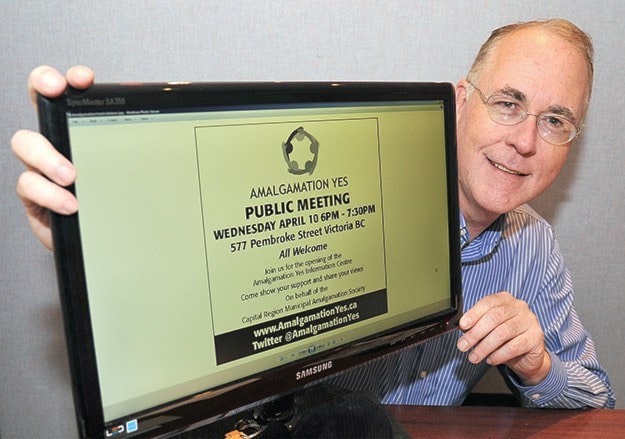Part 2: Halifax weighs in on amalgamation
Part 1: 3 cities, 7 districts, 2 towns and a township
Driving from one job in Saanich to another in Victoria, Mike Miller describes the varying development bylaws he needs to remember each time builds a new home in the Capital Region.
“There’s really nothing the same between each municipality,” says Miller, Victoria president of the Urban Development Institute and local residential developer.
“You apply for rezoning, apply for a development permit, go through council, but there isn’t one system or set of processes.”
Miller is one example of a local business owner who struggles with a mixed bag of bureaucracy working in the region’s 13 municipalities.
Members of real estate boards, chambers of commerce and industry professionals quietly lament the inefficiencies of the current system.
Amalgamation advocate John Vickers counts himself among the voters who had hoped things would change after the 2011 municipal election.
“There were a multitude of community discussion groups popping up on their own around amalgamation … people who just didn’t feel their voice was heard,” says Vickers, organizer of the Victoria buskers festival and chalk art festival.
Victoria Coun. Shellie Gudgeon and others began holding public talks on regional government last year after many of the region’s mayors failed to identify amalgamation as a priority. Autonomous citizen groups eventually found one another, and after much discussion they emerged as a non-profit society known as Amalgamation Yes.
“The mission is to achieve more effective governance,” says Gudgeon, one of the society’s founders.
“This has been an experience of amalgamating the amalgamators (and) it’s not been easy. Our group is a living example that we can achieve success by listening to each other and by working together.”
Along with Gudgeon, the society’s founders include a former B.C. deputy minister, a retired RCMP officer, a Victoria neighbourhood association chair, a lawyer and communications experts. For a complete list, see amalgamationyes.ca.
The society hosts its first public meeting tonight (April 10) at their newly leased office at 577 Pembroke St.
“We are expecting membership into the hundreds, if not thousands,” Vickers says. “I have yet to find anyone at any of my talks who said they wanted to keep 13 municipalities.”
While opinions vary on what amalgamation should look like, Amalgamation Yes is focused on one goal for the time being: asking voters what they think at the 2014 municipal elections.
“If we can have a loud, clear voice at the ballot box, that people want change … the onus is then on the provincial government to respond,” Vickers says.
If voters give a thumbs up to study amalgamation, it would implore municipal councillors and the provincial government to begin work on specifics, says society co-founder Mat Wright.
“Until we have a comprehensive study, it’s kind of irrelevant to come up with maps and models because we all come at it with a different knowledge base, which is not complete,” he says.
Voters would then vote in a referendum to approve or reject amalgamation. Wright believes opposition isn’t going to come from the public, but rather “the city managers and senior bureaucrats who are afraid of losing their jobs.”
The group also hopes to debunk the idea that amalgamation will only benefit the core communities, by pointing to initiatives from West Shore and Saanich Peninsula councillors.
Colwood Coun. Shari Lukens has ignited a discussion that could lead to a study of the potential benefits of amalgamation in her region.
She notes that Colwood and View Royal have an innovative auto-aid agreement that allows both departments to act as a single service for significant emergencies.
“The regionalization of services is a good start, but how do you rationalize saying ‘let’s amalgamate?’ You need a business case and we don’t have that yet,” Lukens says.
Central Saanich, North Saanich and Sidney have also batted around ideas on shared resources. However, talks with senior staff are in the early stages and mayors won’t move forward without seeing benefit to their communities, says Sidney Mayor Larry Cross.
“The other side of this is access,” he says. “People get to me pretty readily in Sidney right now. If your organization is too big, you’re kept from meeting with the public.”
Provincial and federal funding would also be easier to access without competition from other municipalities, Wright says.
“When you increase the population size over 100,000, the municipality can then apply for federal grants without having to go through the CRD. There’s only one municipality out of the 13 that can do that right now and that’s Saanich.”
For now, Amalgamation Yes members plan to ignite dialogue with dissenters and supporters alike, and anticipate the first definitive read of what Greater Victoria residents think of amalgamation come 2014.
“I just know there’s a better way of governing ourselves,” Vickers says.
dpalmer@vicnews.com
Timeline of Greater Victoria municipal incorporations
Before 1950, there were only four municipalities in Greater Victoria: Esquimalt, Oak Bay, Saanich and Victoria. By 1988, there were 10. Langford, the Highlands and Sooke carved out their own borders in the 1990s to round out the current 13 municipalities.
Saanich, March 1, 1906
Oak Bay, July 2, 1906
Esquimalt, Sept. 1, 1912
Central Saanich, Dec. 12, 1950
Sidney, Sept. 30, 1952
North Saanich, Aug. 19, 1955
Capital Regional District, Feb. 1, 1966
Metchosin, Dec. 3, 1984
Colwood, June 24, 1985
View Royal, Dec. 5, 1988
Langford, Dec. 8, 1992
Highlands, Dec. 7, 1993
Sooke, Dec. 7, 1999
